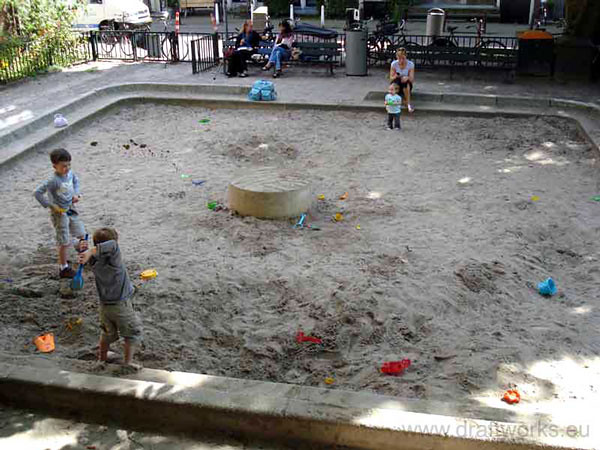 At the west side of the old city centre of Amsterdam, off Haarlemmstraat (a small street with local stores and cute lunch shops) there is the old ‘West-Indisch Huis’ aka the home of the Dutch ‘West-Indies Company’, the organisation responsible for the Dutch colonial activity during the 17th century (The NY city founding pact was signed there in 1625).
At the west side of the old city centre of Amsterdam, off Haarlemmstraat (a small street with local stores and cute lunch shops) there is the old ‘West-Indisch Huis’ aka the home of the Dutch ‘West-Indies Company’, the organisation responsible for the Dutch colonial activity during the 17th century (The NY city founding pact was signed there in 1625).
Now, hidden behind the building there is one of the most well preserved Aldo van Eyck’s playgrounds. I had the chance to visit it exactly three years ago in August 2009, during a research trip to the playgrounds. In the middle of it there is a rectangular sandpit. It is ten by ten meters in size with a short continuous concrete verge surrounding it and a cylindrical altar-like stone in the middle. Three children were playing in it the day we visited it, totally absorbed by the world of their play. I stood there for a few minutes and imagined how the sandpit would work in the children’s imagination: the verge could take the form of a monumental wall, or a home couch, or a long table, and the altar would count as an imaginary large magical stone, or a stove to bake sand-balls or even the centre around which the world turns. However, the most prevailing element of all was the sand. It filled the sandpit and with its uneven surface looked like a stormy sea. The sand created the impression of a matter that there was always there and not just as an infill of the pit, like a primordial substratum that extended underneath the whole city. What kind of force could create this absurd impression?
Van Eyck in his writings highlights the importance of children’s imagination, not as a cute childish thing, but as a power that can motivate the city. He discusses that imagination is the form of power that can re-combine things creatively, that can transform things and he pushes his argument so far as to support that eventually the only things that exist are those that are filtered through imagination:
'All things are recreated continually in the mind through the power of imagination –they would not exist otherwise, for only what passes through imagination really ‘exists’ –consciously or unconsciously – and is born anew. As all things pass through the continuum of man’s mind –the continuum of interiorized reality –they merge, become permeable and are recreated, transformed’ Aldo van Eyck, Writings
Looking back at the sandpit through the filter of imagination one could probably agree that it was not just a pit filled with sand. The concrete verge worked as a frame that opened a window to a second ground of the city, below the first man-made one, connecting our reality with a mythical landscape. We were lucky enough to catch a glimpse of this landscape through the frame of this pit. The verge, the altar and mainly the fluid matter of the sand were then formed in the hands of the children into small fictional worlds. Shouldn't the city offer such kinds of matter which, like sand, can be formed in the hands of children? Or in the imagination of the adults?
[draftworks*2012]
[draftworks*2012]

No comments:
Post a Comment